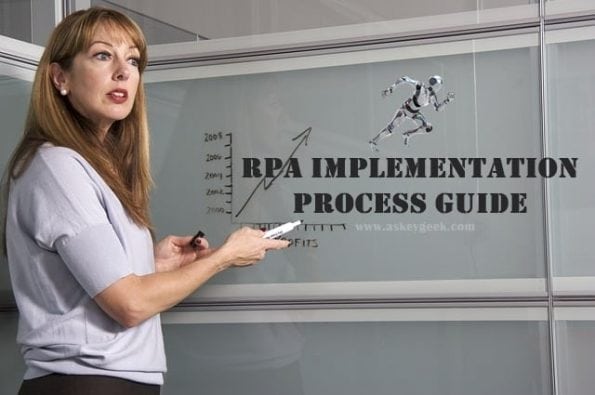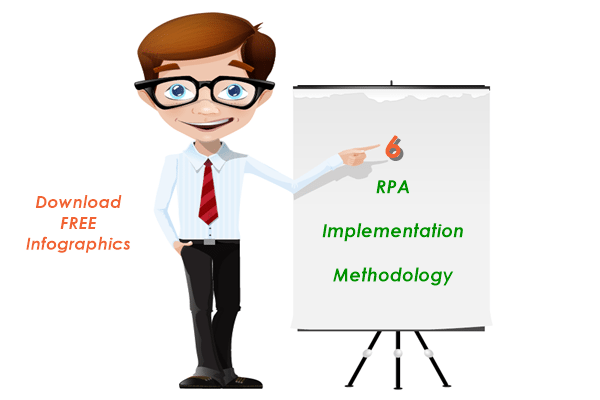This RPA Journey tutorial specifically focuses on the RPA Implementation Process or the Steps to be followed during the RPA implementation process.
I hope you have already read the Ultimate RPA Guide for Beginners before proceeding with this tutorial. If not, I would suggest you have a quick glance on the same. The Ultimate RPA Guide for Beginners is for the absolute beginners who wants to know everything about Robotic Process Automation (RPA) in a layman’s language.
From the inception to the saturation there are multiple stages to be passed through in this journey. This RPA implementation methodology has been prepared after a few years of research and studies. I have tried to cover all the aspects in this tutorial.
Follow the below step by step instructions for a successful
RPA implementation.
 Pin
Pin
First thing first! I would like to consider RPA implementation as a journey rather than a Project.
Identify the Automation Opportunities
This should be first step of the rpa journey, I call it as the “WHAT” step. You need to identify what all you can automate. To make this step easy I have made a list of areas that you can quickly look for identifying automation opportunities.
- Rule Driven Processes
- Repetitive Processes
- Data entry Processes
- Volumes Driven Processes
- Frequent human errors
Optimize the Identified Processes
This is an important step after an automation opportunity has been identified. Optimize the existing process before jumping into automating it in the ‘As Is’ way of process. Analyze the existing the process and identify the improvement areas using the quality techniques like Lean, Kaizen etc. Before you start with the RPA implementation all the inefficiencies in the existing process should have been removed.
Build Business Case for the RPA Journey
This is more of the initial documentation process, I call it as the “WHY” step. In this step you need to document the key areas of this automation journey. You can prepare a well drafted Business Case covering all the below points.
- Why does this automation require?
- What are the benefits because of this automation
- What are the pain areas that can be removed because of the automation?
- Identify the extended impacts of this automation; process that might affect this RPA automation
- Define the metrics to measure the automated process
- Define the span of control ratio between the bot and human
- What is the plan of action for re-deploying the existing resources after automation
RPA Vendor Selection
This is the “HOW” stage of RPA journey, in this stage you can choose from 2 options, either you can develop an in-house automation, or you can buy a solution which is already available in the market. RPA is growing rapidly and there are multiple vendors providing RPA solutions (UiPath, Blueprism, Automation Anywhere etc.) . I have covered more than 20 vendors & tools in the earlier post (You can refer the same for more details).
Also, there are many factors need to consider before selecting any robotic process automation tool depending upon the industry you are operating. Some of the factors like:
- Technology
- Interface
- Management
- Security
- Pricing
Each of these RPA tool selection checklists are covered in detail in the RPA Ultimate Tutorial, you should refer the same for more details.
It is also advisable to have a look into the automation solutions used by other companies as well within your industry. Which will give you more insights and try to leverage your network to understand more about the processes that have already been automated by others using RPA.
I have made a list companies using different robotic process automation, which will be helpful for this analysis.
Pilot RPA Development
This is where the initial rpa bot development or programming begins. Here you have 2 options either you can hire trained RPA developers, or you can train your SMEs (Subject Matter Experts) on the RPA tool which you have finalized. Both the options come with its own advantages and disadvantages.
The RPA developer who comes with automation experience will be faster in terms of development but might take time to understand process that need to be automated.
Whereas an SME has the expertise on the process, but he/she might take time to learn the RPA solution.
Considering the fact RPA is Code Free or minimal code requirement, if the SME has the potential and eagerness to learn the RPA tool then I would suggest the latter will be a better option for your Pilot RPA development.
Many of the RPA tools have a Free/Community version or a Trail version available with lots of training materials, which can be actually leveraged for a kick start.
Companies have already started training their existing SMEs/resources on the RPA solutions which are useful to their business needs most.
Based experience the suggested approach for an RPA implementation is to target for the quick wins, minimum risk and quick returns in the initial stage and then slowly move on to the expertise bot buildings.
Slow and steady wins the race is the best suggested approach for a successful RPA implementation.
Some of the factors need to be considered during the pilot RPA development are:
- How long should your pilot be?
- Plan for the programming/development
- Plan for the change management
- Plan for the pilot launch
- Plan for the risk management during the pilot stage.
- Evaluate ‘What Went Well’ and ‘What Could Have Been Better”
Ramp up and Continue Building Expertise RPA bots
This is the stage where you write your (Success) story and expand your RPA scope, and as per me this is where your RPA journey begins. You should create a beautiful story to leverage your success, your story should contain the below points:
- Process
- Business Challenge
- Solutions used
- Business benefit: Human work saved, ROI achieved, Accuracy achieved, Time saved, Peak volume handled in terms of SLA etc.
- Other processes in scope of automation after the Pilot RPA implemented.
I have summarized these RPA Implementation steps in the below Infographics, feel free to share it!
 Pin
Pin



5 Responses
This is one of the best RPA articles I have read and the process is self-explanatory looking at the approach.
Infrrd AI platform converts unstructured data into structured format & helps RPA customers get more value from their investments.
Our Image recognition and OCR technology dramatically reduces these changes to make sure you get a higher ROI from your RPA investments
Great insights shared on the various stages of RPA implementation. If you can share the learning model of RPA as well, it would be of good help.
Hello Anson
Really appreciate the effort for this useful blog.I am also a IT Consultant,works in one of the MNC in Bangalore.
Thanks for the valuable information on RPA.
Regards
krishnaprasad